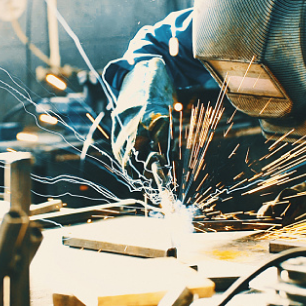Jump to:
Guidelines for Electrode Material Selection in Resistance Welding
Selecting the correct electrode material and geometry is critical to achieving consistent, high-quality welds, but it can be a complex process. While this Q&A focuses primarily on electrode materials, it’s important to note that factors such as part geometry, dissimilar metals, and varying material thicknesses also play a role in determining the optimal solution.
Below are some frequently asked questions that can help guide material selection for resistance welding applications.
Q: What electrode material should I use for my spot welding application?
A: Great question. RWMA Class 2 copper is the standard go-to material for most spot welding applications due to its balance of electrical and thermal conductivity and good strength. However, the following special considerations apply:
- For welding aluminum or certain copper alloys, RWMA Class 1 (high conductivity, lower strength) is typically used.
- For harder materials, or where higher strength is needed, RWMA Class 3 may be more appropriate.
- For very thin-gauge pure copper, RWMA Class 13 or 14 can offer better wear resistance and stability.
Remember, material strength typically decreases as conductivity increases, so choosing the right class involves balancing these properties based on your specific application.
Q: What electrode material is best for projection welding?
A: Another excellent question. Projection welding typically requires materials that can withstand higher forces and concentrated heating at the weld projection points. RWMA Class 3 copper and refractory metal composites like Elkonite are commonly used. Other suitable classes include RWMA 10, 11, and 12, especially at the projection location.
It’s also common practice to use inserts of these materials, which can be bolted, brazed, or otherwise mounted to a base electrode body to improve service life and performance while managing costs.
Q: How does electrode selection affect my weld schedule?
A: Electrode material can significantly determine weld parameters such as current, force, and weld time. Different materials conduct heat and electricity at different rates, which directly impacts how heat is generated and maintained during welding.
The RWMA Resistance Welding Manual is a valuable resource for a deeper dive. It provides detailed guidance on electrode materials, geometries, and shapes as well as recommendations for various weld schedules based on industry-
standard practices.
By understanding how material properties interact with welding variables, you can make informed decisions that improve both weld quality and electrode life. For more information, visit the RWMA section on the AWS website or consult the latest edition of the RWMA Resistance Welding Manual.
This article was written by Jason Lisko (sales application engineer, resistance welding and automation, at Taylor-Winfield Technologies Inc., Youngstown, Ohio) for the American Welding Society.


